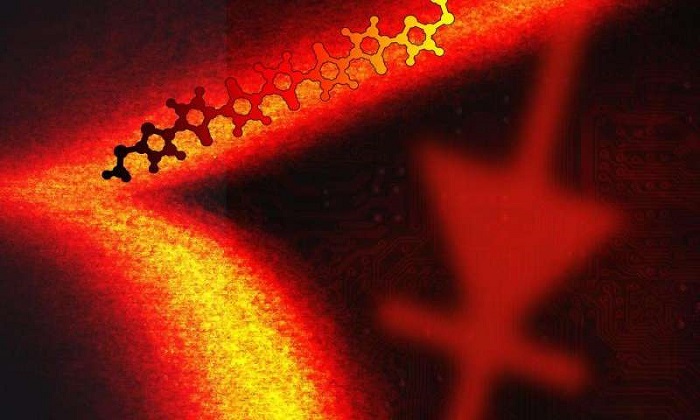A new technique developed for creating molecular diodes has not only been created, it’s proven to perform 50 times better than all previous designs.
 Illustration of a single-molecule diode with a non-trivial rectification ratio overlaid on the raw current versus voltage data.
Illustration of a single-molecule diode with a non-trivial rectification ratio overlaid on the raw current versus voltage data.
The team that created this design was led by Latha Venkataraman, an associate professor of applied physics at Columbia Engineering. Venkataraman’s group is the first ever to achieve a single-molecule diode, and many consider their technology to not only be a new benchmark, but something that will see real-world applications for nanoscale devices.
“Our new approach created a single-molecule diode that has a high (>250) rectification and a high “on” current (~ 0.1 micro Amps),” says Venkataraman. “Constructing a device where the active elements are only a single molecule has long been a tantalizing dream in nanoscience. This goal, which has been the 'holy grail' of molecular electronics ever since its inception with Aviram and Ratner's 1974 seminal paper, represents the ultimate in functional miniaturization that can be achieved for an electronic device.”
The single-molecule diode comes at a perfect time, what with electronic devices becoming smaller and smaller every day. Professionals working in molecular electronics have been facing a real problem in trying to keep pace with the demand for smaller technologies, while also overcoming limitations of miniaturization.
Now, while the single-molecule diode is a monumental achievement in and of itself, it’s not a new idea: it was actually suggested by Arieh Aviram and Mark Ratner, who first theorized in 1974 that a molecule could act as a rectifier, a one-way conductor of electric current. Since then, researchers have been exploring the charge-transport properties of molecules. During the decades of subsequent reporting thereafter, it’s been proven that single-molecules attached to metal electrodes can be made to act as a variety of circuit elements, including resistors, switches, transistors, and diodes. Also, researchers have shown that it is possible to see quantum mechanical effects like interference manifest in the conductance properties of molecular junctions.
But in order for a diode to act like an electricity valve, its structure needs to be asymmetric, so the electricity flowing in one direction experiences a different environment than electricity flowing in the other direction.
“While such asymmetric molecules do indeed display some diode-like properties, they are not effective,” explains Brian Capozzi, a PhD student working with Venkataraman and lead author of the paper. “A well-designed diode should only allow current to flow in one direction—the 'on' direction—and it should allow a lot of current to flow in that direction. Asymmetric molecular designs have typically suffered from very low current flow in both 'on' and 'off' directions, and the ratio of current flow in the two has typically been low. Ideally, the ratio of 'on' current to 'off' current, the rectification ratio, should be very high.”
To achieve asymmetric molecular design, Venkataraman and her colleagues — Chemistry Assistant Professor Luis Campos' group at Columbia and Jeffrey Neaton's group at the Molecular Foundry at UC Berkeley — focused on developing an asymmetry in the environment around the molecular junction.
Specifically, they created an environmental asymmetry by surrounding the active molecule with an ionic solution and using gold metal electrodes of different sizes to contact the molecule.
The result was rectification ratios as high as 250, which is 50 times higher than earlier designs. The “on” current flow in their devices can be more than 0.1 microamps which, all things considered, is a lot of current passing through a single-molecule.
The researchers point out that because their technique is so easily implemented, it can be applied to all nanoscale devices of all types, including those made with graphene electrodes.
“It's amazing to be able to design a molecular circuit, using concepts from chemistry and physics, and have it do something functional,” Venkataraman says. “The length scale is so small that quantum mechanical effects are absolutely a crucial aspect of the device. So it is truly a triumph to be able to create something that you will never be able to physically see and that behaves as intended.”
Looking ahead, Venkataraman and her team will now begin to work on better understanding the fundamental physics behind their discovery. They will also look to increase the rectification ratios they reported by using new molecular systems.
To read the published report, entitled Single-molecule diodes with high rectification ratios through environmental control , head to Nature Nanotechnology.
Via: Phys.org
Advertisement
Learn more about Electronic Products Magazine





